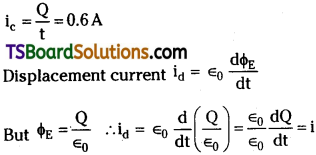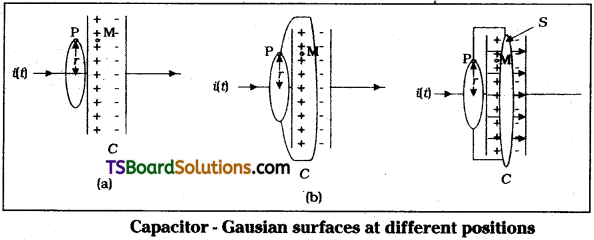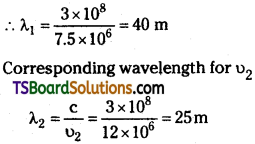Telangana TSBIE TS Inter 2nd Year Physics Study Material 11th Lesson Electromagnetic Waves Textbook Questions and Answers.
TS Inter 2nd Year Physics Study Material 11th Lesson Electromagnetic Waves
Very Short Answer Type Questions
Question 1.
What is the average wavelength of X-rays?
Answer:
Wavelength range of X-rays = 10-8 m to 10-13 m i.e., 1 nm to 10-4 nm.
∴ Average wavelength of X-rays is \(\frac{1+10^{-4}}{2}\) nm = 0.5 nanometers (nearly)
Question 2.
Give any one use of infrared rays. [TS Mar. ’19; AP May ’18. ’17]
Answer:
- Infrared detectors are used in satellites both for military purpose and to observe growth of crops.
- Infrared radiation is responsible to keen the atmosphere warm through green house effect.
Question 3.
If the wavelength of electromagnetic radiation is doubled, what happens to die energy of photon? [TS Mar. ’16; June ’15]
Answer:
Energy of electromagnetic photon E = hυ = \(\frac{hc}{\lambda}\)
So when wavelength λ is doubled energy of photon is reduced to half.
Question 4.
What is the principle of production of electromagnetic waves?
Answer:
Electromagnetic waves are produced by accelerating charges through conductors.
Question 5.
How are Microwaves produced? [AP Mar. ’15]
Answer:
Microwaves can be produced by special type of vacuum tubes. Namely Klystrons, magnetrons and yun diodes.
![]()
Question 6.
What is sky wave propagation? [AP June ’15]
Answer:
In the frequency range from a few MHz upto about 30 MHz, long distance communication can be achieved by the ionospheric reflection of radio waves back towards the earth. This mode of propagation is called sky wave propagation and it is used by short wave broadcast services.
Question 7.
What is the ratio of speed of infrared rays and ultraviolet rays in vacuum?
Answer:
Ratio =1:1
In vacuum speed of electromagnetic waves v = \(\frac{1}{\sqrt{\mu_0 \epsilon_0}}\)
It is applicable to whole range of electromagnetic spectrum.
∴ In vacuum velocity of UV rays = Velocity of I.R rays.
Question 8.
What is the relation between the amplitudes of the electric and magnetic fields in free space for an electromagnetic wave?
Answer:
Amplitude of Magnetic field
![]()
Relation between amplitude of Magnetic field B0 and Electric field E0 in vacuum is B0 = \(\frac{E_0}{c}\)
Question 9.
What are the applications of microwaves? [AP Mar. 18, 17, 15; May 18, 16 , 15; June 15; TS Mar. 18, 17,15, May. 18]
Answer:
- Microwaves are widely used in radar because of their small wavelength.
- Microwaves are used in microwave ovens due to the frequency of microwave region is nearly equals to resonant frequency of water molecule.
Question 10.
Microwaves are used in Radars, why?
Answer:
Due to short wavelengths microwaves are suitable for the radar systems used in air craft navigation.
![]()
Question 11.
Give two uses of infrared rays. [TS Mar. ’17; May ’16; AP Mar. ’19, ’16; May ’14]
Answer:
- Infrared detectors are used in satellites both for military purpose and to observe growth of crops.
- Infrared radiation is responsible to keen the atmosphere warm through green house effect.
Question 12.
The charging current for a capacitor is 0.6 A. What is the displacement current across its plates?
Answer:
Charging current i = conduction current

∴ Displacement current id = 0.6 A across the plates.
Short Answer Questions
Question 1.
What does an electromagnetic wave consists of? On what factors does its velocity in vacuum depend?
Answer:
According to Maxwell’s theory, accelerated charges radiate electromagnetic waves.
Suppose a charge oscillates with some frequency. It produces an oscillating electric field in space. This oscillating electric field produces oscillating magnetic field. It again regenerates oscillating electric field. These electric and magnetic fields are mutually perpendicular and also perpendicular to direction of propagation. Electric field component Ex = E0 sin (kz – ωt) Magnetic field component By = B0 sin (kz – ωt)
where k = \(\frac{2 \pi}{\lambda}\) and speed of wave v = \(\frac{\omega}{k}\)
According to Maxwell’s equations, relation between E0 and B0 \(\frac{E_0}{B_0}\) = c or B0 = \(\frac{E_0}{c}\)
In vaccum velocity of electromagnetic wave c = \(\frac{1}{\sqrt{\mu_0 \epsilon_0}}\)
∴ Velocity of electromagnetic wave in vacuum depends on permeability µ0 and permittivity ∈0 of vacuum.
Question 2.
What is Greenhouse effect and its contribution towards the surface temperature of earth?
Answer:
Greenhouse effect :
Infrared rays plays an important role in maintaining average temperature of earth’s atmosphere.
During daytime, earth absorbs the energy of incoming Infrared & Visible radiation from Sun. As a result earth’s surface get heated. Hot earth will reradiate energy in the form of infrared radiation.
Many molecules such as Carbon dioxide (CO2), Ammonia (NH3), Chloro Fluoro Carbons, Methane (CH4), etc. will absorb the long range infrared radiation because the resonant frequency of these gases matches with infrared region. So energy reradiated by earth is trapped by these molecules as a result earth’s atmosphere is heated. This is known as “greenhouse effect”.
Effect of greenhouse gases :
When concentration of greenhouse gases such as CO2, NH3, CH4 etc., increases average temperature of .earth is also gradually increase. This effect is called global warming.
Long Answer Questions
Question 1.
Give the brief history of discovery of knowledge of electromagnetic waves.
Answer:
Maxwell conducted an experiment to apply the ampere’s law to study the magnetic field at a point outside the capacitor by applying a time varying current.

Consider a point ‘P’ outside the parallel plate capacitor [See Fig (a)]. Consider a loop of radius ‘r’. Its direction is perpendicular to the conductor.
From Amperes Law B(2πr) = µ0 i (t) → (1)
Consider another different surface [See Fig (b)]. It is a pot like dielectric surface without electrical contact with capacitor plate. But it encloses the capacitor plate.
By applying ampere’s Law LHS of eq. (1) is not changed but RHS = 0. Because there is no current flowing in the plate.
∴ B(2πr) = 0 → (2)
Consider another surface like a tiffin box [See Fig (c)] apply ampere’s circuital law with same parameters LHS of eq (1) is same. But RHS is zero
i.e. B(2πr) = 0 → (3)
From eq. (1) there is a magnetic field at ‘P’ But for the figures (b) & (c) field at ‘P’ is zero. So there is some contradiction in calculating magnetic field.
Maxwell suggested that there is some electric field E = \(\frac{Q}{Ae_0}\) between the plates
and it is perpendicular to the plates. E has some value in between the plates and vanishes outside the plate.
Electric flux between the plates ΦE = |E|A\(\frac{Q}{\epsilon_0}\)
Charge Q on plates of capacitors changes with time as a result ΦE changes with time.
Changing electric flux will produce the current called displacement current id = ∈0\(\frac{\mathrm{d} \phi_{\mathrm{E}}}{\mathrm{dt}}\).
So Maxwell suggested that source of magnetic field is not only due to conduction current ic
but due to a total current i = ic + id and

So source of magnetic field is not just conduction current, it is also produced by displacement current.
Displacement current will have same physical properties just like conduction current.
Basing on this he formulated that a time varying electric field will produce a time varying magnetic field. Similarly a time varying magnetic field will produce a time varying electric field. In this way energy oscillates between perpendicular electric and magnetic fields in an electromagnetic wave.
![]()
Question 2.
State six characteristics of electromagnetic waves. What is Greenhouse effect?
Answer:
From Maxwell’s theory
- accelerated charges radiate electromag¬netic waves.
- Frequency of electromagnetic wave is equal to frequency of oscillator.
- Energy associated with the propagation of wave is obtained from oscillating source.
- From Maxwell’s equations relation between E0 and B0 is \(\frac{E_0}{B_0}\) = c or B0 = \(\frac{E_0}{c}\)
- In vacuum velocity of electromagnetic wave c = \(\frac{1}{\sqrt{\mu_0 \epsilon_0}}\)
- Hertz experiments on electromagnetic waves showed that electromagnetic waves of wavelength 10 million times more than light waves could be diffracted, reflected and polarised.
Electromagnetic waves carry energy and momentum like other waves. - In vacuum speed of electromagnetic waves v = \(\frac{1}{\sqrt{\mu_0 \epsilon_0}}\)
It is applicable to whole range of electromagnetic spectrum.
Greenhouse effect :
Infrared rays plays an important role in maintaining average temperature of earth’s atmosphere.
During daytime earth absorbs the energy of incoming Infrared & Visible radiation comming from Sun. As a result earth’s surface get heated. Hot earth will reradiate energy in the form of infrared radiation.
Many molecules such as CO2 Ammonia (NH3), Chloro Fluro Carbons, Methane CH4 etc., will absorb the long range infrared radiation because the resonant frequency of these gases matches with infrared region. So energy reradiated by earth is trapped by these molecules as a result earth’s atmosphere is heated. This is known as “greenhouse effect”.
Intext Question and Answers
Question 1.
What physical quantity is the same for X- rays of wavelength 10-10 m, red light of wavelength 6800 Å and radiowaves of wavelength 500 in?
Answer:
The speed of light (3 × 108 m/s) in a vacuum is the same for all wavelengths. It is independent of the wavelength in the vacuum.
Question 2.
A plane electromagnetic wave travels in ‘ vacuum along z-direction. What can you say about the directions of its electric and magnetic field vectors? If the frequency of the wave is 30 MHz, what is its wavelength?
Answer:
The electromagnetic wave travels in a vacuum along the z-direction. The electric field (E) and the magnetic field (H) are in the x-y plane. They are mutually perpendicular.
Frequency of the wave, o = 30 MHz
= 30 × 106 s-1
Speed of light in a vacuum, c = 3 × 108 m/s
Wavelength of a wave is given as, λ = \(\frac{c}{v}\)
\(\frac{3\times10^8}{30\times10^6}\) = 10 m
Question 3.
A radio can tune into any station in the 7.5 MHz to 12 MHz band. What is the corresponding wavelength band?
Answer:
A radio can tune to minimum frequency, υ1 = 7.5 MHz = 7.5 × 106 Hz
Maximum frequency, υ2 = 12 MHz
= 12 × 106 Hz ;
Speed of light, c = 3 × 108m/s
Relation between λ and υ is λ1 = \(\frac{c}{υ_1}\)

Thus the wavelength band of the ratio is 40 m to 25 m.
Question 4.
A charged particle oscillates about its mean equilibrium position with a frequency of 109 Hz. What is the frequency of the electromagnetic waves produced by the oscillator?
Answer:
The frequency of an electromagnetic wave produced by the oscillator is the same as that of a charged particle oscillating about its mean position i.e., 109 Hz.
![]()
Question 5.
The amplitude of the magnetic field part of a harmonic electromagnetic wave in vacuum is B0 = 510 nT. What is the amplitude of the electric field part of the wave?
Answer:
Magnetic field B0 = 510 nT = 510 × 10-9 T ;
Speed of light in a vacuum, c = 3 × 108 m/s
Amplitude of electric field of the electromagnetic wave is given by the relation,
E = cB0 = 3 × 108 × 510 × 10-9 = 153 N/C
Therefore, the electric field part of the wave is 153 N/C.